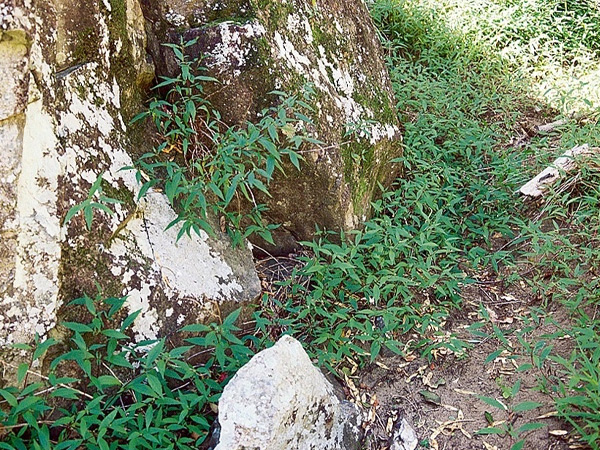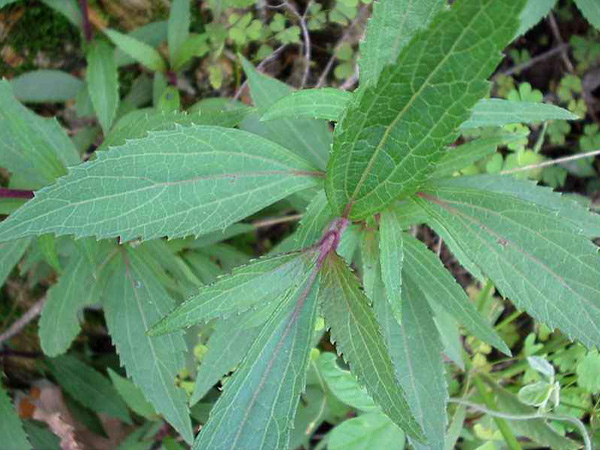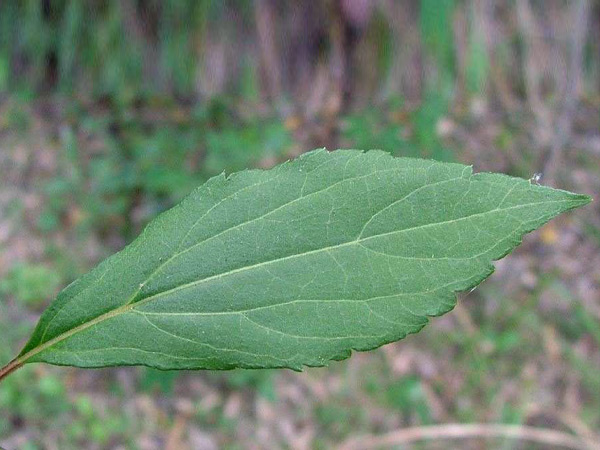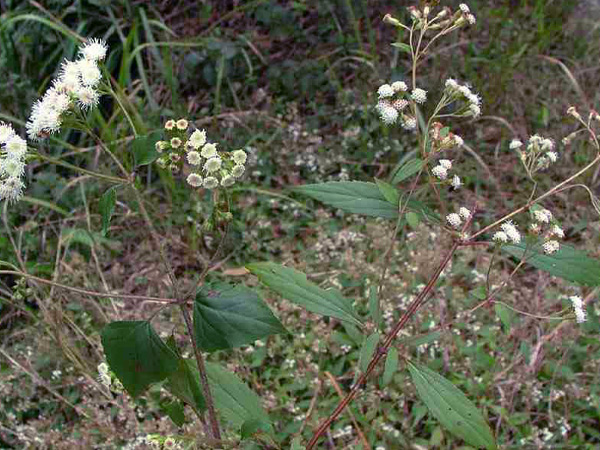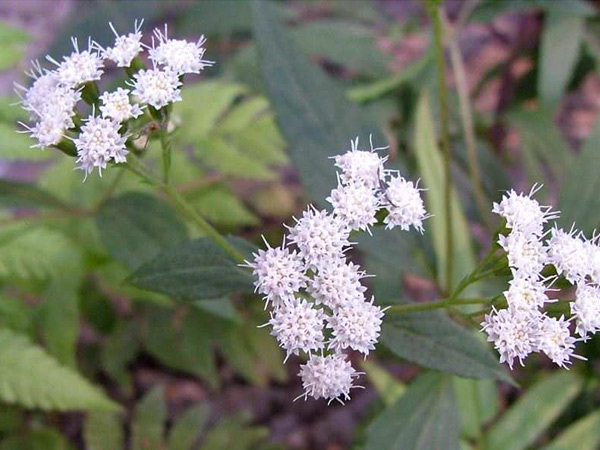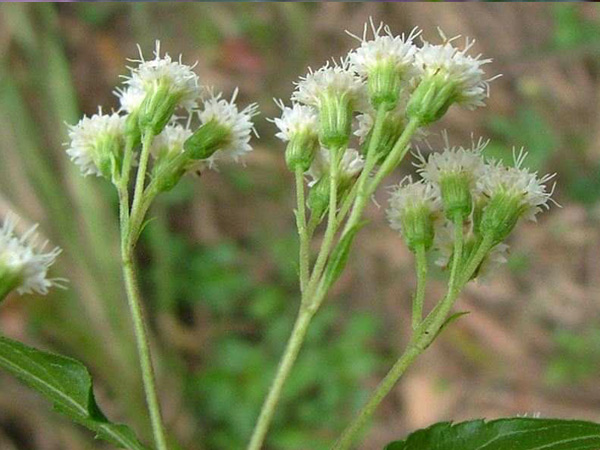Weeds
Mistflower – Ageratina riparia
Introduced as a garden plant in the 1870s, mistflower is now an invasive weed of native bushlands, riverine habitats and pastures in sub-tropical climates.
Profile
How does this weed affect you?
Introduced as a garden plant in the 1870s, mistflower is now an invasive weed of native bushlands, riverine habitats and pastures in sub-tropical climates.
An aggressive invader of pastures, mistflower can reduce pasture production, leading to a significant decline in carrying capacity. It can quickly invade hillsides, shaded riverbanks, gullies and disturbed areas such as roadsides. Of particular concern is the invasion and domination of bushland edges and riverine groundcover. In these situations it competes with native vegetation and can displace native animals that rely on the habitat for food and shelter.
Where is it found?
Native to Central America, mistflower has been introduced to many parts of the world as a garden ornamental. It is now a serious weed in many countries including New Zealand, India, Indonesia, the USA, Papua New Guinea, and some Pacific Islands. It is also a weed in the tropical and subtropical areas of Africa and Southeast Asia.
In Australia it is found along the eastern coastline from Yandina, Queensland in the north to Jervis Bay, NSW in the south. It is mostly prevalent in southeast Queensland and the north coast of New South Wales.
How does it spread?
Mistlflower spreads by seed. Most seed is dispersed by wind and water, although human intervention is also responsible for its spread. This includes seed contamination in agricultural produce, roadside soil movement and transportation of seed attached to vehicles and machinery.
Existing infestations increase in size and density by forming a mat of layered and interwoven stems.
Lifecycle
Seeds germinate late spring to summer, usually following the first rain of the season. Seedlings and mature plants experience rapid growth during the summer. Growth begins to slow as winter approaches. Plants begin to bud from July, with full flowering occurring from August to October. Ripe seeds are shed 3–4 weeks after the flowers open. Each plant can produce 10 000–100 000 seeds annually. Plants die back after flowering and re-shoot from the base.
What does it look like?
A low-growing perennial herb that commonly grows 40–60 cm high. It occasionally reaches heights of 1 m.
Stems
- spreading and branched
- produce roots at the joints where they touch the ground
Leaves
- green, with toothed edges
- arranged oppositely along the branch
- up to 3–13 cm long and 1–4 cm wide
- on a stalk 1–2 cm long
Flowers
- white, 4–6 mm wide
- fluffy in appearance
- tubular with 5 lobes
- occur in clusters of up to 30 at the end of braches
Seed
- dark brown to black
- 1–2 mm long
- 4–5 hairy ridges that run lengthwise
- topped with a ring of 3–4 mm long bristles
Root
- short, thick rootstock
- many fibrous roots extend downwards and outwards
What type of environment does it grow in?
Mistflower prefers humid sub-tropical climates with an annual rainfall over 700 mm. Shade tolerant, it is commonly found along shaded, damp creek banks, on damp south-facing hillsides amongst rocks and in other moist, sheltered areas. It does not tolerate frost.
Acknowledgements
Written by Rachele Osmond.
Reviewed by Rod Ensbey.
References
Biosecurity Queensland (2014) Fact sheet PP20–Mistflower: Ageratina riparia. Department of Agriculture, Fisheries and Forestry, Brisbane. Available at http://www.daff.qld.gov.au/__data/assets/pdf_file/ 0011/72866/IPA-Mistflower-PP20.pdf
Department of the Environment (2011) Weeds in Australia: Ageratina riparia. Australian Government. Available at: http://www.environment.gov.au/biodiversity/invasive/weeds/identification/index.html
Hosking JR, Sainty GR, Jacobs SWL & Dellow JJ (in prep) The Australian WeedBOOK
Morin L, Piper M, White A and Schooler S (2012) Spread, specificity and initial impact of the white-smut fungus Entyloma ageratinaeon mistflower in Australia in Proceedings of the18th Australasian Weeds Conference, Melbourne.
Parsons, WT and Cuthbertson, EG (2001) Noxious weeds of Australia, CSIRO Publishing, Collingwood.
Porteners, MF (2014) Ageratina riparia (Regel) R.M.King & H.Rob., in PlantNET – The Plant Information Network System of The Royal Botanic Gardens and Domain Trust, Sydney, Australia. Available at http://plantnet.rbgsyd.nsw.gov.au
Control
Mistflower control is best conducted when infestations are small to prevent establishment. All control options should be conducted prior to flowering and seed set. Always monitor control efforts and conduct follow-up control as required.
Manual control
Small and light infestations can be manually removed by hand or with a hoe. Larger infestations may be slashed or cultivated where appropriate. This should be followed by planting competitive pasture species or native vegetation. In steep and/or rocky areas, mechanical control may not be a feasible option.
Herbicide control
Many herbicides are registered for the control of mistflower. Herbicides can be used on all infestation sizes. A foliar spray application should be conducted prior to flowering and when plants are actively growing. Choose an appropriate herbicide for the situation and conditions.
Pasture management
Strong competition from pasture species will help prevent mistflower from establishing and assist in preventing re-establishment following control. Provide competition by managing stocking rates to avoid over grazing and apply fertiliser to encourage vigorous pasture growth. Pasture re-establishment may be necessary in dense infestations following herbicide control. Ideally, newly established pastures should not be grazed until they have seeded. Spot spray any mistflower regrowth.
Biological control
The white-smut fungus (Entyloma ageratinae) has shown to have promising results on the control of mistflower. It is widespread throughout many mistflower infestations from south-eastern Queensland through to the south coast of NSW.
White-smut fungus has shown to cause defoliation, causing plant stress, but does not appear to kill the plant. Other means of control will also be required in the management of mistflower.
